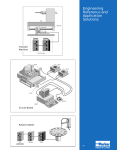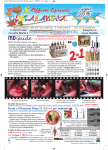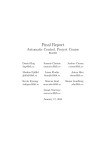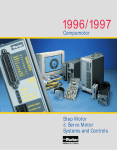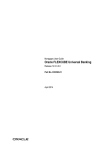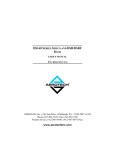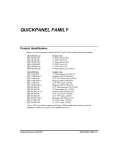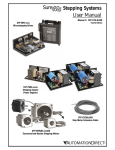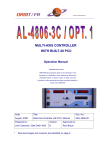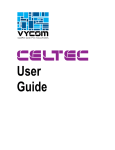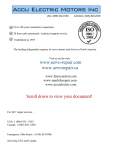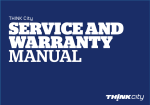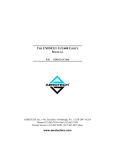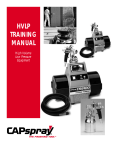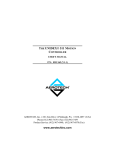Download the aom360 series positioning gimbal mount
Transcript
THE AOM360 SERIES POSITIONING GIMBAL MOUNT USER’S MANUAL P/N: EDA123 (V1.1) AEROTECH, Inc. • 101 Zeta Drive • Pittsburgh, PA. 15238-2897 • USA Phone (412) 963-7470 • Fax (412) 963-7459 Product Service: (412) 967-6440; (412) 967-6870 (Fax) www.aerotech.com If you should have any questions about the AOM and/or comments regarding the documentation, please refer to Aerotech online at: http://www.aerotech.com. For your convenience, a product registration form is available at our web site. Our web site is continually updated with new product information, free downloadable software, and special pricing on selected products. The AOM360 Series Positioning Gimbal Mount User’s Manual Revision History: Rev 1.0 Rev 1.1 January 24, 1994 February 1, 2001 AOM360 Series User’s Manual Table of Contents TABLE OF CONTENTS CHAPTER 1: 1.1. 1.2. 1.3. CHAPTER 2: 2.1. 2.2. CHAPTER 3: 3.1. 3.2. 3.3. CHAPTER 4: GENERAL ........................................................................................ 1-1 Introduction ........................................................................................ 1-1 Description ......................................................................................... 1-2 Maintenance ....................................................................................... 1-2 SETUP ............................................................................................... 2-1 Installation .......................................................................................... 2-1 2.1.1. Read Instructions.................................................................. 2-1 2.1.2. Unpack Mount...................................................................... 2-1 2.1.3. Prepare Mounting Surface.................................................... 2-1 2.1.4. Bolt Down Mount................................................................. 2-1 Adjusting the Leveling Screw Assembly ............................................ 2-3 MOUNT TESTING .......................................................................... 3-1 Introduction ........................................................................................ 3-1 Equipment .......................................................................................... 3-1 Test Procedures .................................................................................. 3-2 3.3.1. Accuracy and Bi-Directional Repeatability.......................... 3-2 3.3.2. Wobble................................................................................. 3-3 3.3.3. Orthogonality ....................................................................... 3-3 APPLICATION NOTES.................................................................. 4-1 4.1. 4.2. Introduction ........................................................................................ 4-1 Application Sizing Information .......................................................... 4-1 4.2.1. Stable/Motor Sizing Considerations..................................... 4-1 4.2.2. Resolution/Speed.................................................................. 4-1 4.2.3. Peak Torque Acceleration .................................................... 4-2 4.2.4. RMS Torque......................................................................... 4-2 4.2.5. Sine Wave Approximations.................................................. 4-3 4.2.6. Acceleration/Velocity/Displacement.................................... 4-3 4.3. 4.4. 4.5. 4.6. Fastening the Application ................................................................... 4-5 Temperature Effects ........................................................................... 4-5 Load Capability and Life Expectancy................................................. 4-5 Formulas............................................................................................. 4-5 4.2.6.1. Duty Cycle ...................................................................... 4-4 CHAPTER 5: 5.1. 5.2. CHAPTER 6: 6.1. 6.2. 6.3. 6.4. 6.5. Version 1.1 VACUUM OPERATION................................................................. 5-1 Introduction ........................................................................................ 5-1 Prep for Vacuum Operation................................................................ 5-1 SPECIFICATIONS .......................................................................... 6-1 AOM360 Positioning Gimbal Mount Specifications.......................... 6-1 Drive Specifications ........................................................................... 6-2 Resolution and Accuracy.................................................................... 6-2 Maximum Velocity............................................................................. 6-2 Definitions of Specifications .............................................................. 6-3 6.5.1. Accuracy .............................................................................. 6-3 6.5.2. Hysteresis ............................................................................. 6-3 Aerotech, Inc. iii Table of Contents AOM360 Series User’s Manual 6.5.3. 6.5.4. 6.5.5. 6.5.6. 6.5.7. 6.5.8. 6.5.9. 6.5.10. CHAPTER 7: 7.1. 7.2. 7.3. 7.4. Life ....................................................................................... 6-3 Maximum Speed................................................................... 6-3 Output Torque (static) .......................................................... 6-3 Orthogonality........................................................................ 6-3 Range.................................................................................... 6-3 Repeatability......................................................................... 6-5 Resolution............................................................................. 6-5 Wobble ................................................................................. 6-5 ELECTRICAL.................................................................................. 7-1 Introduction ........................................................................................ 7-1 Optical Limit Switch Assembly .......................................................... 7-2 Limit Operation (for limited travel only) ............................................ 7-2 Limit Interface .................................................................................... 7-2 APPENDIX A: WARRANTY AND FIELD SERVICE .......................................... A-1 INDEX ∇ ∇ ∇ iv Aerotech, Inc. Version 1.1 AOM360 Series User’s Manual List of Figures LIST OF FIGURES Figure 1-1. AOM360D Series Optical Mount....................................................... 1-1 Figure 2-1. Figure 2-2. AOM360 Series Positioning Gimbal Mount Dimensions................... 2-2 Leveling Screw Assembly .................................................................. 2-3 Figure 6-1. Figure 6-2. Accuracy and Repeatability for AOM360 (Assembled Unit) ............. 6-4 Wobble ............................................................................................... 6-6 ∇ ∇ ∇ Version 1.1 Aerotech, Inc. v List of Figures vi AOM360 Series User’s Manual Aerotech, Inc. Version 1.1 AOM360 Series User’s Manual List of Tables LIST OF TABLES Table 6-1. Table 6-2. Table 6-3. Table 6-4. AOM360D Positioning Gimbal Mount Specificaitons ....................... 6-1 Drive Specifications ........................................................................... 6-2 Resolution and Accuracy.................................................................... 6-2 Maximum Velocity............................................................................. 6-2 Table 7-1. Limit Interface Jumpers...................................................................... 7-2 ∇ ∇ ∇ Version 1.1 Aerotech, Inc. vii List of Tables viii AOM360 Series User’s Manual Aerotech, Inc. Version 1.1 General AOM360 Series User’s Manual CHAPTER 1: GENERAL In This Section: • Introduction ................................................ 1-1 • Description .................................................. 1-2 • Maintenance ............................................... 1-2 1.1. Introduction This manual describes technical information needed for typical applications of the AOM Series Gimbal Positioning Mounts. It includes instructions that detail the entire installation, from unpacking to start-up. Also included are concise explanations concerning applications and the maintenance of the mechanical and electrical components. In addition, there is a section defining the specifications pertinent to the AOM360. It is advisable that the user read the entire manual before removing the mount from the package. Figure 1-1. Version 1.1 AOM360D Series Optical Mount Aerotech, Inc. 1-1 AOM360 Series User’s Manual 1.2. General Description The AOM360 Series Mount combines precise positioning capability with excellent dynamic performance and speed capability. This mount series is a compact, backlash-free system (see Section 7.1) that includes: • • • • • • • • • • • Large diameter ABEC-7 angular contact bearings (low axis wobble to 3 arc/sec) Hardened alloy steel rotary bearings Steel housings Optional limit switches, tachometer, slip ring aperture, and special cells Compatibility with a full line of Aerotech positioning stages and motion controls Choice of DC servo motors (torque) Choice of rotary encoders or Inductosyn (accuracy) Standard home marker Optional "Absolute Positioning" type encoders Optional preparation for vacuum operation (10-6 torr) Orthogonality to 5 arc/sec Use the Aerotech Motion Control Product Guide for the "Glossary of Mechanical Terminology", drawings, specifications, and general system information. 1.3. Maintenance The bearings do not require re-lubrication under normal use. ∇ ∇ ∇ 1-2 Aerotech, Inc. Version 1.1 Setup CHAPTER 2: AOM360 Series User’s Manual SETUP In This Section: • Installation................................................... 2-1 • Adjusting the Leveling Screw Assembly..... 2-3 2.1. Installation This section covers the handling, mounting, and installation of the AOM360 Series Mounts. For added clarity, each step of the installation instructions has been broken down into component parts. The AOM360 Mount should only be installed by those who read and thoroughly understand this manual. Each step appears below. 2.1.1. Read Instructions When performing the installation instructions, do not continue to the next step until you have properly completed the previous step(s). 2.1.2. Unpack Mount Carefully remove the mount from the protective shipping container. Place the mount on a smooth, flat, and clean surface. This is a simple, yet very important step in maintaining the integrity of the mount. You will notice a label that will include a system part number and serial number. Record these numbers for they contain all the information necessary to maintain or update system hardware and software. Also, find the enclosed customer service information and accuracy certification. If it is obvious that damage occurred during shipping, report it immediately. It is wise to save the shipping container for possible use in the future. Improper handling of the mount could adversely affect the performance specifications. Therefore, use care when moving the mount. Do not allow the mount to drop onto the mounting surface. Set it down gently. 2.1.3. Prepare Mounting Surface The mounting surface used with the AOM360 Series Mount should be coplanar within 0.0001 in/in for valid accuracy. For example, if the longest distance between the base hole pattern is 8 inches, then the mounting surface should be coplanar within 0.0008 inches. This makes a reference surface to start with. Use the leveling screws as shown in Figure 2-2 to achieve the desired level. 2.1.4. Bolt Down Mount All size stages use either 1/2-13 or M12 hardware. Make sure that the screw does not bottom out before it tightens against the mount. Version 1.1 Aerotech, Inc. 2-1 AOM360 Series User’s Manual Setup T 3 Mounting Bolts with Leveling Screws N Radius Clearance Component Mounting Surface M A H I B Component Retaining Clips (3) Drive Assembly (elevation axis) C.A C (AOM360D-16 & -20 only) G Elevation Axis D L E Drive Assembly (azimuth axis) F Connectors K Motor and position transducer connectors. Quantity, size and location may vary depending on transducer. S R J 2 P Dimensions: Millimeters [Inches] Model A B C D E F G H AOM360D-20 524.0 [20.63] 212.1 [8.35] – 552.7 [21.76] 419.4 [16.51] 235.0 [9.25] 205.5 [8.09] 46.0 [1.81] AOM360D-30 609.6 [24.00] 260.4 [10.25] – 642.9 [25.31] 465.1 [18.31] 247.6 [9.75] 307.8 [12.12] 60.5 [2.38] AOM360D-40 825.5 [32.50] 384.0 [15.12] 441.5 [17.38] 817.1 [32.17] 582.2 [22.92] 385.8 [15.9] 409.4 [16.12] 74.7 [2.94] AOM360D-50 939.8 [37.00] 441.5 [17.38] 546.1 [21.50] 931.4 [36.67] 639.3 [25.17] 443.0 [17.44] 511.0 [20.12] 101.6 [4.00] K L M N O P Q R AOM360D-20 328.9 [12.95] 521.0 [20.51] 18.3 [0.72] 313.12 [12.33] 355.6 [14.00] 252.2 [9.93] 13.5 [0.53] 14.2 [0.56] AOM360D-30 374.7 [14.75] 566.7 [22.31] 23.6 [0.93] 353.3 [13.91] 355.6 [14.00] 252.2 [9.93] 13.5 [0.53] 14.2 [0.56] AOM360D-40 440.4 [17.34] 743.5 [29.27] 31.0 [1.22] 463.5 [18.25] 401.3 [15.80] 322.6 [12.70] 13.5 [0.53] 25.4 [1.00] AOM360D-50 497.6 [19.59] 800.6 [31.52] 44.5 [1.75] 517.6 [20.38] 401.3 [15.80] 322.6 [12.70] 13.5 [0.53] 25.4 [1.00] 1. Non-standard azimuth/elevation motor combinations may alter dimensions. Please consult factory for dimension verification. 2. Quantity and size of connectors will vary depending on transducer type. (1) Figure 2-1. 2-2 I 41.4 [1.63] 53.8 [2.12] 63.5 [2.50] 88.9 [3.50] S 235.0 [9.25] 235.0 [9.25] 284.2 [11.9] 284.2 [11.9] J 114.3 [4.50] 114.3 [4.50] 228.6 [9.00] 228.6 [9.00] T 137.5 [5.38] 150.9 [5.94] 177.8 [7.00] 177.8 [7.00] AOM360 Series Positioning Gimbal Mount Dimensions Aerotech, Inc. Version 1.1 Setup 2.2. AOM360 Series User’s Manual Adjusting the Leveling Screw Assembly When adjusting the Leveling Screw Assembly, follow the procedure listed below. See Figure 2-2 for exact locations of components. 1. Place Spherical Washers with the spherical side in the seat as shown on both ends of the Jack Screw. 2. To adjust for level: A. Verify that the Fastener (1/2 - 13) is loose. B. Loosen the Jam Nut with a 1 1/4" wrench. C. Adjust the height using a 1" wrench on the Jack Screw, the rate of displacement is approximately 0.032" per CW turn. D. Re-tighten the Jam Nut. Fastener Spherical Washer Jack Screw Jam Nut Spherical Washer Figure 2-2. Leveling Screw Assembly ∇ ∇ ∇ Version 1.1 Aerotech, Inc. 2-3 AOM360 Series User’s Manual 2-4 Aerotech, Inc. Setup Version 1.1 Mount Testing CHAPTER 3: AOM360 Series User’s Manual MOUNT TESTING In This Section: • Introduction ....................................................3-1 • Equipment .......................................................3-1 • Test Procedures ...............................................3-2 3.1. Introduction This section outlines the steps needed to mechanically test the Aerotech AOM360 Gimbal Positioning Mount. The mount is equipped with an Azimuth (AZ) direct drive motor, an Elevation (EL) direct drive motor, a yoke, and a cell. Aerotech pretests the AZ and EL motors for accuracy and wobble. After final assembly of the mount, Aerotech measures the Orthogonality of the unit. The general procedures for testing the AZ and EL motors are derived from the Aerotech TP300, "Quality Control Inspection Procedure for ART Series Rotary Tables". Each test procedure conforms to guidelines indicated in the National Machine Builder’s Association standard for Definition and Evaluation of Accuracy and Repeatability for Numerically Controlled Machine Tools (August, 1972). Specifically, this standard requires the collection of data to determine quantities such as accuracy, bi-directional repeatability, and wobble. For mount specifications refer to Section 7.1. 3.2. Equipment • Rotary Stage for AZ and EL axis; Machined Yoke • Ultradex (R) Index Table (1 arc-second accuracy) • Moller Wedel 2-Axis Autocollimator • Reference Optical Cube • UNIDEX Controller • Electronic Indicator (to level the Ultradex) • Spindle Mirror Mount Version 1.1 Aerotech, Inc. 3-1 AOM360 Series User’s Manual 3.3. Mount Testing Test Procedures There are many procedures for testing the AOM360 Series Mounts; however, only a few of these procedures are listed below. 3.3.1. Accuracy and Bi-Directional Repeatability After mounting the stage to the test base, set the rotary stage to room temperature (about 68° F) for a minimum of 4 hours. 1. Set the AOM360 horizontally on the granite table (axis of rotation is vertical). Home the stage with the Unidex Controller. Mount the adapter plate to the cell and attach the Ultradex Index Table to the plate. Install the Reference Cube on top of the Ultradex. Position the Moller Wedel Autocollimator approximately 2 feet away from the return mirror, and adjust it until the mirror is centered and perpendicular to the Autocollimator. This returns the beam back upon itself (no angular error). 2. Index the stage to the first position, 10° away (clockwise). 3. Index the Ultradex by the same amount (10°) but in the opposite (counterclockwise) direction. Note the values from the electronic display of the Moller Wedel Autocollimator for the appropriate errors. This is the positioning error. 4. 5. Index the stage to the next sequential test point 10° away (clockwise). 6. 7. Repeat steps 3-5 until the stage is back at 0°. Repeat steps 2-6 in the counter-clockwise direction. This completes the first set of data. Find the biggest difference between the data in each set. The result is accuracy. Find the biggest difference between the CW & CCW at the same angle. This is the bi-directional repeatability. 8. 9. 3-2 Aerotech, Inc. Version 1.1 Mount Testing AOM360 Series User’s Manual 3.3.2. Wobble Set the AZ or EL axis so its axis of rotation is effectively coaxial with the auto collimator. Attach the spindle mirror mount to the cell adapter plate. 1. The process used to align the mirror and autocollimator is interactive. Alternatively adjust the mirror and autocollimator, moving half the observed deviation each time. Begin by adjusting the mirror at the 0° and 180° settings of the tabletop. Then, adjust the 90° and 270° points. Eventually, the effective radius of the circle, traced by the return beam at the autocollimator, should be as small as possible (mirror and collimator are concentric). 2. Zero the autocollimator. 3. 4. Turn the table in 15° increments, and record the deviations. Calculate the average AZ and EL deviations for each set, and use the average values as a zero offset. Calculate the vector sum of the resulting deviations. The difference between the maximum and minimum deviation is the wobble for that set. 3.3.3. Orthogonality Level the AOM360 mount and stabilize it at room temperature for 4 hours. Attach the spindle mirror adapter to the cell. Using the return mirror, secure the spindle mirror to the adapter. Look through the motor and counterweight and verify that the return mirror is visible. Position the autocollimator on the same side as the EL motor and align it roughly with the return mirror (while looking through the EL motor). Rotate the cell through 180° and verify that the collimator is still aligned. Adjust the leveling to assure a return signal. 1. With the cell in a vertical position, align the return mirror concentric with the autocollimator (see 3.3.2). 2. With the cell in its vertical position, use the Unidex Controller to rotate the yoke through 180°. Note the elevation angle change. To find an average elevation angle change, repeat this measurement seven times. The orthogonality is half of the average elevation angle change, since a ray reflects through 2*@ for @ degrees misalignment between axes. Adjust the relative height between the motors until orthogonality meets the specifications. ∇ ∇ ∇ Version 1.1 Aerotech, Inc. 3-3 AOM360 Series User’s Manual 3-4 Aerotech, Inc. Mount Testing Version 1.1 Application Notes CHAPTER 4: AOM360 Series User’s Manual APPLICATION NOTES In This Section: • Introduction ................................................ 4-1 • Application Sizing Information ................... 4-1 • Fastening the Application............................ 4-5 • Temperature Effects .................................... 4-5 • Load Capability and Life Expectancy ......... 4-5 • Formulas...................................................... 4-5 4.1. Introduction After securing the mount, it is time to install the motor drive (see Chapter 8). After becoming comfortable with the drive electronics, verify that the maximum speed is obtainable without encountering any fault conditions (e.g., oscillation of tabletop). Do this before attaching any delicate payloads. Document all results. 4.2. Application Sizing Information Direct motor drives are much more sensitive to loads than are the gear drives. Therefore, it is important for Aerotech to know: load, table orientation, and application. When using this mount in conjunction with a UNIDEX Motion Controller, it is primarily a positioning system. However, in limited applications we can address velocity requirements. Please consult factory with these applications. 4.2.1. Stable/Motor Sizing Considerations The following requirements are critical when considering the final configuration of an AOM360 mount. • Resolution • Speed • Torque • Control/Driver • Tachometer • Holding Brake • Travel Limits • Slip Rings 4.2.2. Resolution/Speed Speed varies depending on the controller, feedback device, and driver. Resolutions of less than 3.6 arc seconds require the use of a linear amplifier or Aerotech Output Filter (AF2). To obtain the amplifier or filter, contact an Aerotech Sales Representative. This is important for minimizing error caused by the amplifier signal. Version 1.1 Aerotech, Inc. 4-1 AOM360 Series User’s Manual Application Notes 4.2.3. Peak Torque Acceleration Taccel = Ttotal – Tfriction (static) Taccel Acceleration (rad/sec2) = J EXAMPLE: 10 ft-lb = 33.33 rad/sec2 .3 ft-lb sec2 33.33 x 360 = 1,900°/sec2 2π 4.2.4. RMS Torque (T12 x t1) + (T22 x t2) + (T33 x t3) Trms = (t1 + t2 + t3) T = Torque t = time EXAMPLE: T2 T3 500°/sec Accel = 1,000°/S2 (17.5 R/S2) J = 1.2 ft-lb S2 T1 1/2 sec 5 sec t2 t1 1/2 sec t3 T1 = 20 ft-lb accel + 1 ft-lb friction T2 = 1 ft-lb friction T3 = 20 ft-lb decel - 1 ft-lb friction Trms = (212 x .5) + (12 x 5) + (192 x .5) 6 Trms = 8.2 ft-lb With 2 sec dwell between moves: Trms = (212 x .5) + (12 x 5) + (192 x .5) + (12 x 2) 8 Trms = 7.1 ft-lb 4-2 Aerotech, Inc. Version 1.1 Application Notes AOM360 Series User’s Manual 4.2.5. Sine Wave Approximations Tpeak = Trms x 1.414 Trms = Tpeak x .707 Peak Torque EXAMPLE: Trms Torque = Peak Torque x .707 = 15 ft-lb x .707 = 10.6 ft-lb Ipeak = Irms x 1.414 = 10 amps x 1.414 = 14.14A 4.2.6. Acceleration/Velocity/Displacement Peak Acceleration Ap = Vp x w Time Peak Velocity Vp = Ap or Vp = Dp x w w Peak Displacement Dp = Vp w Ap = Peak Acceleration Vp = Peak Velocity Dp = Peak Displacement 1 Time Wp = 2πF Fp = Version 1.1 Aerotech, Inc. 4-3 AOM360 Series User’s Manual Application Notes EXAMPLE: 10° /sec .05 sec Ap = Vp x w Ap = 10°/sec x 126 Ap = 1,260°/sec = (22 rad/sec2) Vp Dp = w 10°/sec Dp = 126 Dp = .079° Taccel = Ap x J Taccel = 22 rad/sec2 x .3 ft-lb sec2 Taccel = 6.6 ft-lb Taccel = Taccel + Tfriction = 6.6 ft-lb + .75 ft-lb = 7.35 ft-lb Trms Trms Trms = Tpeak x .707 = 7.35 ft-lb x .707 = 5.2 ft-lb 4.2.6.1. T = .05 sec 1 sec = 20 Hz F= .05 w = 2π x 20 Hz = 126 J = .3 ft-lb sec2 Vp = 10°/sec Friction = .75 ft-lb Duty Cycle This cycle remains on for 6 seconds, off for 2 seconds. Trms = (5.22 x 6) + (.752 x 2) 8 sec Trms = 4.5 ft-lb 4-4 Aerotech, Inc. Version 1.1 Application Notes 4.3. AOM360 Series User’s Manual Fastening the Application When fastening the payload to the cell, make sure the mounting interface is coplanar within 0.000 010 in/in for valid accuracy. To achieve this, scrape or shim until no rocking occurs in the cell. To minimize the amount of surface needed to be coplanar, use feet or pads on the mounting surface. 4.4. Temperature Effects The permissible ambient temperature operating range of the table assembly is 32°F to 140 °F (0°C to 60°C) in a non-condensing atmosphere. The thermal expansion and contraction cause the geometry of the mount to vary slightly with temperature. The best accuracy for the AOM360 Series is at 68°F (20°C). 4.5. Load Capability and Life Expectancy The positioning accuracy specification of the AOM360 is measured at the center of a 25 pound payload on the center of the cell (stage in horizontal position). See Chapter 7 for loading specifications. It is recommended that the application provides for a symmetrically distributed load (i.e., always center the payload on the cell and the entire stage centered on the support structure). Loading capacity and life expectancy are directly related. A higher load decreases the life expectancy. To determine the life expectancy under a given application, follow the method outlined in the Aerotech Motion Control Product Guide, Glossary Section. This allows adjustment of the life based on the amount of loading in the longitudinal direction and the cantilevered moment generated from that loading. 4.6. Formulas For a quick reference during load calculations, use the following Metric to English conversion factors. 1 kg = 2.2 pounds 2.54 cm = 1 inch 1 kg-cm = 13.9 oz-in 16 oz-in-sec2 = 1 lb-in-sec2 1 rev. = 2π radians ∇ ∇ ∇ Version 1.1 Aerotech, Inc. 4-5 AOM360 Series User’s Manual 4-6 Aerotech, Inc. Application Notes Version 1.1 Vacuum Operation CHAPTER 5: AOM360 Series User’s Manual VACUUM OPERATION In This Section: • Introduction ................................................ 5-1 • Prep for Vacuum Operation ........................ 5-1 5.1. Introduction As an option, Aerotech will prepare the AOM360 Series Mount for operation in a vacuum environment. 5.2. Prep for Vacuum Operation Meticulous attention to detail during the modification, cleaning, and assembly results in a stage with optimal performance in high vacuum applications (10-6 torr). Some of the features of this preparation include: 1. Lubrication with vacuum compatible lubricants. 2. Use of only materials with negligible outgassing under vacuum. 3. Elimination of situations that may allow gases to become temporarily trapped during pump-down. 4. Extensively cleaned and baked-out before being specially assembled in a clean environment and packed in a nitrogen filled bag. To insure that the mount will continue to perform well in vacuum, follow the additional guidelines below: 1. Handling - Do not remove the mount from the sealed bag until ready for use. When handling, use teflon gloves in a clean environment to prevent any contaminants from adhering to the mount. When the mount is not in use for an extended duration, place it in a sealed container. 2. Installation - Use cleaned, vented, stainless steel fasteners when securing the mount. 3. Applications - In a vacuum environment, the lack of conductive heat transfer could result in excessive motor operating temperatures. This coupled with the viscous nature of vacuum compatible greases will make it necessary to derate performance specifications. To reduce the amount of heat generated for low duty cycle applications, we offer special controllers that reduce the current supplied to the motor when idle. For applications that require additional performance, contact our applications engineers about implementing a cooling system. 4. Lubrication - Use only small quantities of Apiezon L grease or a substitute of equivalent quality. ∇ ∇ ∇ Version 1.1 Aerotech, Inc. 5-1 AOM360 Series User’s Manual 5-2 Aerotech, Inc. Vacuum Operation Version 1.1 Specifications AOM360 Series User’s Manual CHAPTER 6: SPECIFICATIONS In This Section: • AOM360 Positioning Gimbal Mount Specifications........ 6-1 • Drive Specifications ......................................................... 6-2 • Resolution and Accuracy ................................................. 6-2 • Maximum Velocity .......................................................... 6-2 • Definitions of Specifications ............................................ 6-3 6.1. AOM360 Positioning Gimbal Mount Specifications Table 6-1. AOM360D Positioning Gimbal Mount Specificaitons Basic Model AOM360D-20 Total Travel AOM360D-30 AOM360D-40 AOM360D-50 360° continuous, both azimuth and elevation Clear Aperture Diameter (1) 193.5 mm (7.6 in) Mechanical Drive System Maximum Rotary Speed 292.1 mm (11.5 in) 393.7 mm (15.5 in) 489.0 mm (19.3 in) Direct Drive Brushless Servo Motor (2) 50 rpm Maximum Diameter 203.2 mm (8 in) 304.8 mm (12 in) 406.6 mm (16 in) 508.0 mm (20 in) Load Thickness 40.6 mm (1.5 in) 53.3 mm (2.1 in) 63.5 mm (2.5 in) 88.9 mm (3.5 in) Parameters Weight 7.0 kg (15.4 lbs) 10.0 kg (22.0 lbs) 25.0 kg (55.1 lbs) 50.0 kg (110.2 lbs) Axis Azimuth 3 arc sec (0.00083°) Wobble Elevation 5 arc sec (0.0014°) Orthogonality Finish 10 arc sec (0.0028°); 5 arc sec (0.0014°) optional Paint: Textured Epoxy (Polane-T), Pebble Grey Color 1. Special cell adapters and slip ring assemblies available by special order. 2. Maximum speed based on stage capability; maximum application velocity may be limited by system data rate and system resolution Version 1.1 Aerotech, Inc. 6-1 AOM360 Series User’s Manual 6.2. Specifications Drive Specifications Table 6-2. Drive Specifications 'ULYHU 0RWRU&RGH &DEOH %DVLF0RGHO %XV &XUUHQW $ ''0''( RU $ '6/'6 9'& $ ''0''1 $ $ 8VH''(FDEOHFRPELQDWLRQIRUHQFRGHUHTXLSSHGVWDJH''1IRU,QGXFWRV\QHTXLSSHGVWDJH 2. Larger torque motors available by special order. 6.3. Resolution and Accuracy Table 6-3. Resolution and Accuracy Transducer Required Interpolation (2) Resolution and Repeatability Code Type (1) Format RE30 Encoder 90000 ppr x4 ±5 arc sec (0.0014°) 3.6 arc sec (0.001°) RE20 (3) Encoder 18000 ppr x40 ±2.5 arc sec (0.00069°) 1.8 arc sec (0.0005°) RE10 (3) Encoder 36000 ppr x100 ±1 arc sec (0.00028°) 0.36 arc sec (0.0001°) ND50 (3) Inductosyn 7 in dia. 720 poles 12-bit R/D ±2 arc sec (0.00056°) 1 arc sec (0.00028°) ND60 (3) Inductosyn 12 in dia. 720 poles 16-bit R/D ±1 arc sec (0.00028°) 0.1 arc sec (0.000028°) 1. Resolver or absolute encoder also available to provide absolute position reference. 2. Encoder multiplication supplied by times-4 of controller plus external multiplier. 3. Linear motor drivers or PWM output filters required with high resolution systems. 6.4. Maximum Velocity Table 6-4. Maximum Velocity Resolution 6-2 Accuracy (Transducer) Aerotech Controllers U11 U100, U400, U500, U21, U31 72 arc sec (0.02°) 120 rpm (1) 120 rpm (1) 3.6 arc sec (0.001°) 41 rpm 82 rpm (2) 1.8 arc sec (0.0005°) 20.5 rpm 82 rpm 1.0 arc sec (0.00028°) N/A 43 rpm 0.36 arc sec (0.0001°) 4.1 rpm 16.4 rpm 0.1 arc sec (0.000028°) N/A 3.9 rpm 1. Higher speeds available-please consult factory. 2. Limited by encoder data rate. Aerotech, Inc. Version 1.1 Specifications 6.5. AOM360 Series User’s Manual Definitions of Specifications 6.5.1. Accuracy Also referred to as positioning accuracy. For positioning purposes, accuracy is defined as the maximum deviation between the commanded (theoretical) position and the actual position. Aerotech specifications provide for the data to be collected at the intersection of the AZ and EL axis. For example, Figure 6-1 has data collected per Chapter 3. To find time accuracy of column #1, take half the biggest number minus the smallest number. For instance: 2.7−( −2.3) =2 . 5 2 6.5.2. Hysteresis This is a component of bi-directional repeatability. Upon reversing direction, a deviation between the actual and commanded position is caused by elastic forces in the drive system. 6.5.3. Life This is the minimum rated lifetime (based on the base life) while maintaining positioning specifications. 6.5.4. Maximum Speed This is based on the limiting critical speed of the motor, which in some cases is limited by encoder resolution and controller overhead rate (see Section 6.4). 6.5.5. Output Torque (static) For an AOM360 Mount, this is the maximum permissible applied torque when the mount is at rest. 6.5.6. Orthogonality The condition of a surface or axis perpendicular (offset by 90°) to a second surface or axis. Orthogonality specifications refer to the error from 90° where two surfaces or axes are aligned. 6.5.7. Range This is the maximum allowable travel of a positioning stage. Version 1.1 Aerotech, Inc. 6-3 AOM360 Series User’s Manual Specifications Accuracy and Repeatability for AOM360 (Assembled Unit) Order Number:xxxxx Customer: Test Number: Test Date: 31, Aug. 93 TEST Nominal Position (degrees) 0 10 20 30 40 50 60 70 80 90 100 110 120 130 140 150 160 170 180 190 200 210 220 230 240 250 260 270 280 290 300 310 320 330 340 350 360 CCW 0.30 0.10 -0.10 -0.20 -0.10 -0.10 -0.20 -0.60 -0.60 -1.00 -1.30 -1.50 -1.90 -2.30 -2.20 -2.10 -2.00 -1.80 -1.30 -0.90 -0.20 0.40 1.20 1.70 1.90 2.00 2.30 2.70 2.70 2.50 2.30 2.20 1.70 1.50 1.40 1.30 1.00 #1 CW 0.30 0.30 0.40 0.40 0.60 0.40 0.30 -0.10 -0.20 -0.60 -0.90 -1.30 -1.80 -2.30 -2.10 -2.20 -2.10 -1.50 -1.20 -0.70 0.00 0.50 1.40 1.80 1.80 2.00 2.20 2.60 2.50 2.40 2.20 1.90 1.50 1.20 1.30 0.90 1.00 Figure 6-1. 6-4 #2 Home Accuracy and Repeatability for AOM360 (Assembled Unit) Aerotech, Inc. Version 1.1 Specifications AOM360 Series User’s Manual 6.5.8. Repeatability This is the maximum deviation from the mean (each side) when repeatedly approaching a position. Unidirectional repeatability is the value established by moving toward a position in the same direction. Bi-directional repeatability is the value established by moving toward a position in the same or opposite direction. 6.5.9. Resolution This is the smallest theoretical movement per step of the motor control system. Resolution is based on the smallest discernible motion of the control system. Programming resolution may not necessarily be the same as positioning resolution. 6.5.10. Wobble This is an irregular rocking or staggering motion of the tabletop on a rotary stage. Wobble is defined as the angular error between the actual axis of rotation and the theoretical axis of rotation. See Figure 6-2 on the following page. Version 1.1 Aerotech, Inc. 6-5 AOM360 Series User’s Manual Specifications EL Elevation Axis AZ Axis EL Elevation Axis AZ Axis Azimuth Axis Figure 6-2. Wobble ∇ ∇ ∇ 6-6 Aerotech, Inc. Version 1.1 Electrical CHAPTER 7: AOM360 Series User’s Manual ELECTRICAL In This Section: • Introduction ................................................ 7-1 • Optical Limit Switch Assembly................... 7-2 • Limit Operation (for limited travel only)..... 7-2 • Limit Interface............................................. 7-2 7.1. Introduction Aerotech AOM360 Series Mounts can be supplied with a full line of Aerotech positioning and motion controls. This includes a variety of DC servomotors, amplifiers, position feedback devices, and point-to-point and contouring motion controllers. When the AOM360 Series Mount is part of an Aerotech system refer to the system manuals and documentation for additional installation and operation information. All systems are adjusted for optimum performance. The end user need only connect the interconnecting cable from the drive chassis to the stage, and apply power. Never connect or disconnect any electrical component or interconnecting cable while power is applied. Serious damage will result. WARNING Mounts are labeled as to which drive the electrical cable should be connected. Although similar motor and stage combinations can be interchanged, they should be used with their corresponding drive axis for optimal performance. Version 1.1 Aerotech, Inc. 7-1 AOM360 Series User’s Manual 7.2. Electrical Optical Limit Switch Assembly As an option, the AOM Series Mount may contain an optical limit switch assembly to indicate an over-travel condition. Not only does this optical limit switch assembly board provide mounting for the optical devices, but also has a hysteresis and buffering circuitry for reliable performance. 7.3. Limit Operation (for limited travel only) The optical limit switch assembly is mounted to the main casting beneath the table top with one optical device at each end of the printed circuit board assembly. Each optical device is mounted perpendicular to the direction of travel and includes an emitting light source with a detector. When the actuator blade attached to the carriage interrupts the light path from the emitter to the detector, a clockwise (CW) or counter-clockwise (CCW) limit-n signal (active low) indicates an over-travel condition. 7.4. Limit Interface A six-pin printed circuit board connector is provided for ease of assembly and wiring. The mate to this AMP connector is AMP #640234-6. The following jumper information applies. Table 7-1. Limit Interface Jumpers Pin # Function Notes J1-1 +5V Input +5 @ 25ma J1-2 Reserved J1-3 Signal Common J1-4 Reserved (2) J1-5 CCW Limit-N Active Low (2) J1-6 CW Limit-N Active Low (1) NOTES: 1. For +12V operation, remove wire jumper 1-2 (12V @ 25ma). 2. CMOS output * 5V operation, source 1ma and sink 2.6ma * 12V operation, source 3ma and sink 19ma ∇ ∇ ∇ 7-2 Aerotech, Inc. Version 1.1 Appendix A APPENDIX A: AOM360 Series User’s Manual WARRANTY AND FIELD SERVICE In This Section: • Laser Product Warranty • Return Products Procedure • Returned Product Warranty Determination • Returned Product Non-warranty Determination • Rush Service • On-site Warranty Repair • On-site Non-warranty Repair Aerotech, Inc. warrants its products to be free from defects caused by faulty materials or poor workmanship for a minimum period of one year from date of shipment from Aerotech. Aerotech’s liability is limited to replacing, repairing or issuing credit, at its option, for any products which are returned by the original purchaser during the warranty period. Aerotech makes no warranty that its products are fit for the use or purpose to which they may be put by the buyer, where or not such use or purpose has been disclosed to Aerotech in specifications or drawings previously or subsequently provided, or whether or not Aerotech’s products are specifically designed and/or manufactured for buyer’s use or purpose. Aerotech’s liability or any claim for loss or damage arising out of the sale, resale or use of any of its products shall in no event exceed the selling price of the unit. Aerotech, Inc. warrants its laser products to the original purchaser for a minimum period of one year from date of shipment. This warranty covers defects in workmanship and material and is voided for all laser power supplies, plasma tubes and laser systems subject to electrical or physical abuse, tampering (such as opening the housing or removal of the serial tag) or improper operation as determined by Aerotech. This warranty is also voided for failure to comply with Aerotech’s return procedures. Claims for shipment damage (evident or concealed) must be filed with the carrier by the buyer. Aerotech must be notified within (30) days of shipment of incorrect materials. No product may be returned, whether in warranty or out of warranty, without first obtaining approval from Aerotech. No credit will be given nor repairs made for products returned without such approval. Any returned product(s) must be accompanied by a return authorization number. The return authorization number may be obtained by calling an Aerotech service center. Products must be returned, prepaid, to an Aerotech service center (no C.O.D. or Collect Freight accepted). The status of any product returned later than (30) days after the issuance of a return authorization number will be subject to review. After Aerotech’s examination, warranty or out-of-warranty status will be determined. If upon Aerotech’s examination a warranted defect exists, then the product(s) will be repaired at no charge and shipped, prepaid, back to the buyer. If the buyer desires an air freight return, the product(s) will be shipped collect. Warranty repairs do not extend the original warranty period. Version 1.1 Aerotech, Inc. Laser Products Return Procedure Returned Product Warranty Determination A-1 AOM360 Series User’s Manual Returned Product Nonwarranty Determination Rush Service On-site Warranty Repair Appendix A After Aerotech’s examination, the buyer shall be notified of the repair cost. At such time the buyer must issue a valid purchase order to cover the cost of the repair and freight, or authorize the product(s) to be shipped back as is, at the buyer’s expense. Failure to obtain a purchase order number or approval within (30) days of notification will result in the product(s) being returned as is, at the buyer’s expense. Repair work is warranted for (90) days from date of shipment. Replacement components are warranted for one year from date of shipment. At times, the buyer may desire to expedite a repair. Regardless of warranty or out-ofwarranty status, the buyer must issue a valid purchase order to cover the added rush service cost. Rush service is subject to Aerotech’s approval. If an Aerotech product cannot be made functional by telephone assistance or by sending and having the customer install replacement parts, and cannot be returned to the Aerotech service center for repair, and if Aerotech determines the problem could be warrantyrelated, then the following policy applies: Aerotech will provide an on-site field service representative in a reasonable amount of time, provided that the customer issues a valid purchase order to Aerotech covering all transportation and subsistence costs. For warranty field repairs, the customer will not be charged for the cost of labor and material. If service is rendered at times other than normal work periods, then special service rates apply. If during the on-site repair it is determined the problem is not warranty related, then the terms and conditions stated in the following "On-Site Non-Warranty Repair" section apply. On-site Non-warranty Repair If any Aerotech product cannot be made functional by telephone assistance or purchased replacement parts, and cannot be returned to the Aerotech service center for repair, then the following field service policy applies: Aerotech will provide an on-site field service representative in a reasonable amount of time, provided that the customer issues a valid purchase order to Aerotech covering all transportation and subsistence costs and the prevailing labor cost, including travel time, necessary to complete the repair. Company Address Aerotech, Inc. 101 Zeta Drive Pittsburgh, PA 15238-2897 USA Phone: (412) 963-7470 Fax: (412) 963-7459 TWX: (710) 795-3125 ∇ ∇ ∇ A-2 Aerotech, Inc. Version 1.1 AOM360 Series User’s Manual A Absolute Positioning, 1-2 Acceleration, 4-3 Acceleration/Velocity/Dicplacement, 4-3 Accuracy, 2-1, 3-1, 3-2, 6-3 Accuracy Certification Sheet, 2-1 Accuracy EL, 3-1 Accuracy Specifications, 6-2 Accuracy, AZ, 3-1 Actual Position, 6-3 Adapter Plate, 3-2 Adapter Plate, Cell, 3-3 Adapter, Spindle Mirror, 3-3 Adjusting Height, 2-3 Adjustments, Leveling Screw, 2-3 AF2, 4-1 Aligning the Autocollimator, 3-3 Aligning the Mirror, 3-3 Ambient Temperature, 4-5 Amplifier, 7-1 Amplifier Signal, 4-1 Amplifier, Linear, 4-1 Angle Elevation Change, 3-3 Angular Contact Bearings, 1-2 Angular Error, 6-5 Aperture, Slip Ring, 1-2 Atmosphere, 4-5 Autocollimator, 3-2 Autocollimator Display, 3-2 Autocollimator, Alignment, 3-3 Autocollimator, Beam, 3-3 Average Change in Angle Elevation, 3-3 Axis, AZ, 3-3 Axis, AZ and EL, 3-1 Axis, EL, 3-3 AZ, 3-1 AZ and EL Axis, 3-1 AZ and EL Deviations, Calculated, 3-3 AZ Axis, 3-3 Azimuth, 3-1 B Base, Test, 3-2 Beam, Autocollimator, 3-3 Bearings, Angular Contact, 1-2 Bearings, Rotary, 1-2 Bi-directional Repeatability, 3-1, 3-2, 6-3, 6-5 Bolts, 2-1 Bottomed Out Screws, 2-1 C Cable, 7-1 Version 1.1 Index Calculated AZ and EL, 3-3 Calculating Load, 4-5 Capacity, Load, 4-5 Cell, 3-1, 3-2, 3-3, 4-5 Cell Adapter Plate, 3-3 Cell Rocking, 4-5 Change, Angle Elevation, 3-3 Circle Radius, 3-3 Collection, Data, 3-1 Commanded Position, 6-3 Concentricity, 3-3 Condition, Over-travel, 7-2 Conductive Heat Transfer, 5-1 Configuration, 4-1 Contouring Motion Controller, 7-1 Contraction, Thermal, 4-5 Control/Driver, 4-1 Controller Overhead Rate, 6-3 Controller, Unidex, 3-1, 3-2, 3-3 Conversion Factors, 4-5 Cooling System, 5-1 Cube, Reference, 3-2 Customer Service, 2-1 Cycle, Duty, 4-4 D Damaged Goods, 2-1 Data Collection, 3-1 Data Difference, 3-2 Data, Customer Service, 2-1 DC Servo Motor, 7-1 DC Servo Motors, 1-2 Description, AOM360, 1-2 Deviation, Observed, 3-3 Direct Drive Motor, 3-1 Displacement, 4-3 Displacement, Rate of, 2-3 Display, Electronic, 3-2 Drive Chassis, 7-1 Drive Electronics, 4-1 Drive System, 6-3 Driver, 4-1 Duty Cycle, 4-4 Dynamic Performance, 1-2 E Effects of Temperature, 4-5 EL, 3-1 EL Axis, 3-3 Electronic Display, 3-2 Electronic Indicator, 3-1 Elevation, 3-1 Encoder Resolution, 6-3 Encoders, Rotary, 1-2 Aerotech, Inc. i Index AOM360 Series User’s Manual Environmental Factors, 4-5, 5-1 Error, 6-3 Error Minimizing, 4-1 Error, Amplifier, 4-1 Error, Positioning, 3-2 Errors, 3-2 Expansion, Thermal, 4-5 Expected Life, 4-5 F Fastener, 2-3 Fault Conditions, 4-1 Feedback Device, 4-1 Feet, 4-5 Field Service Information, A-1 Field Service Policy, A-1 Filter, Output, 4-1 Formulas, 4-5 G Glossary of Terms, 1-2 Granite Table, 3-2 H Handling, 1-1 Hardware, 2-1 Hardware, Leveling, 2-1 Hardware, Vacuum Operation, 5-1 Height Adjustment, 2-3 Holding Brake, 4-1 Home, 3-2 Home Marker, 1-2 Horizontal Positioning, 3-2 Housing, 1-2 I Identification Tag, 2-1 Improper Handling, 2-1 Index Table, 3-2 Index Table, Ultradex, 3-1 Index, Stage, 3-2 Indexing, 3-2 Indicator, Electronic, 3-1 Inductosyn, 1-2 Inspection Procedure, Quality Control, 3-1 Installation, 1-1 Installation, Motor Drive, 4-1 Instructions, Install, 2-1 Instructions, Unpack, 2-1 Interconnecting Cable, 7-1 ii J Jack Screw, 2-3 Jam Nut, 2-3 Jam Nut Adjustment, 2-3 L Labels to Identify, 2-1 Leveling, 2-3, 3-3 Leveling Screw Assembly, 2-3 Leveling Screws, 2-1 Life Expectancy, 4-5 Limit Interface, 7-2 Limit Switch, 1-2 Limit Switch Assembly, 7-2 Linear Amplifier, 4-1 Load Capability, 4-5 Load Capacity, 4-5 Low Duty Cycle Applications, 5-1 Lubrication, 1-2 Lubrication, Vacuum, 5-1 M Maximum Speed, 4-1 Maximum Velocity Specifications, 6-2 Mean Deviation, 6-5 Methods for Testing, 3-1 Metric to English Conversions, 4-5 Mirror Alignment, 3-3 Mirror Mount, 3-1 Mirror Mount, Spindle, 3-1, 3-3 Mirror, Return, 3-2, 3-3 Moller Wedel 2-xis Autocollimator, 3-1 Motion Controller, 3-1, 3-2, 3-3 Motion Controllers, 1-2 Motor, 3-3 Motor Drive Installation, 4-1 Motor, AZ, 3-1 Motor, EL, 3-1 Mount Bolting, 2-1 Mount Leveling, 3-3 Mount Rocking, 6-5 Mount Stabilizing, 3-3 Mount Storage, 5-1 Mount, Geometry of:, 4-5 Mounting, 1-1 Mounting Surface, 2-1 N National Machine Builder’s Association, 3-1 Nut, Jam, 2-3 Aerotech, Inc. Version 1.1 AOM360 Series User’s Manual O Observed Deviation, 3-3 Offset, Zero, 3-3 Optical Cube, Reference, 3-1 Optical Limit Switch Assembly, 7-2 Orthogonality, 3-1, 3-3 Oscillation, 4-1 Output Filter, 4-1 Over-travel Condition, 7-2 P Pads, 4-5 Part Number, System, 2-1 Payload, 4-5 Payloads, 4-1 Performance Specifications, 2-1 Performance, Dynamic, 1-2 Permissible Load, 4-5 Plate, Adapter, 3-2 Point-to-point Motion Controller, 7-1 Position Feedback Device, 7-1 Positioning Accuracy, 4-5, 6-3 Positioning Capability, 1-2 Positioning Error, 3-2 Positioning Stages, 1-2 Positioning the Mount, 2-1 Positioning, Absolute, 1-2 Positioning, Horizontal, 3-2 Preparation for Vacuum Application, 1-2 Preparing the Mounting Surface, 2-1 Procedures, Testing, 3-1 Product Damage, 2-1 Product Handling, 1-1 Product Information Sheet, 2-1 Product Installation, 1-1 Product Mounting, 1-1 Pump-down, 5-1 Index Rotary Encoders, 1-2 Rotary Stage, 3-1, 3-2, 6-5 Rotate, Yoke, 3-3 S Screw, Jack, 2-3 Screws, Leveling, 2-1 Securing the AOM360, 1-1 Serial Number, System, 2-1 Servo Motors, DC, 1-2 Setup, 2-1 Shipping Label, 2-1 Slip Ring Aperture, 1-2 Software, 2-1 Specifications, Performance, 2-1 Specifying Velocity, 4-1 Speed, 4-1 Speed/Resolution, 4-1 Spherical Washer, 2-3 Spindle Mirror Adapter, 3-3 Spindle Mirror Mount, 3-3 Spindle Mirror Mount, 3-1 Stage, 7-1 Stage Boundaries, 6-3 Stage Homing, 3-2 Stage Indexing, 3-2 Stage, Positioning, 1-2 Stage, Rotary, 3-1, 3-2 Staggering Motion, 6-5 Storing the Mount, 5-1 Switch, Limit, 1-2 System Components, 1-2 System Configuration, 4-1 System Hardware, Update, 2-1 System Labeling, 2-1 System Part Number, 2-1 System Serial Number, 2-1 System Software, Update, 2-1 T Q Quality Control, 3-1 R Radius, Circle, 3-3 Rate of Displacement, 2-3 Reference Cube, 3-2 Reference Optical Cube, 3-1 Repeatability, Bi-directional, 3-1, 3-2 Requirements, Velocity, 4-1 Resolution, 4-1 Resolution Specifications, 6-2 Resolution/Speed, 4-1 Return Mirror, 3-2, 3-3 Rotary Bearings, 1-2 Version 1.1 Table, Granite, 3-2 Tachometer, 1-2, 4-1 Temperature, 3-2 Temperature Effects, 4-5 Terms, Glossary of:, 1-2 Test Base, 3-2 Testing Procedures, 3-1 Theoretical Position, 6-3 Thermal Contraction, 4-5 Thermal Expansion, 4-5 Torque, 4-1, 6-3 TP300, 3-1 Trapped Gases, 5-1 Travel Limits, 4-1 Aerotech, Inc. iii Index AOM360 Series User’s Manual U Ultradex, 3-2 Ultradex’, 3-2 Ultradex Index Table, 3-1 Ultradex Indexing, 3-2 Unidex Controller, 3-1, 3-2, 3-3, 4-1 Unidirectional Repeatability, 6-5 Unstable Motion, 6-5 Update System Hardware, 2-1 Update System Software, 2-1 W Warranty Information, A-1 Warranty Policy, A-1 Washer, Spherical, 2-3 Wobble, 3-1, 3-3 Y Yoke, 3-1 Yoke Rotation, 3-3 V Vacuum Applications, 5-1 Vacuum Handling, 5-1 Vacuum Installation, 5-1 Vacuum Prep, 1-2 Velocity, 4-1, 4-3 Z Zero Offset, 3-3 ∇ ∇ ∇ iv Aerotech, Inc. Version 1.1 READER’S COMMENTS AEROTECH R The AOM360 Series Positioning Gimbal Mount User's Manual P/N EDA 123, February, 2001 Please answer the questions below and add any suggestions for improving this document. Is the information: Yes No Adequate to the subject? ____ ____ Well organized? ____ ____ Clearly presented? ____ ____ Well illustrated? ____ ____ Would you like to see more illustrations? ____ ____ Would you like to see more text? ____ ____ How do you use this document in your job? Does it meet your needs? What improvements, if any, would you like to see? Please be specific or cite examples. _____________________________________________________________________ _____________________________________________________________________ _____________________________________________________________________ _____________________________________________________________________ _____________________________________________________________________ _____________________________________________________________________ Your name ________________ Your title ________________ Company name ________________ Address ________________ ________________ Remove this page from the document and fax or mail your comments to the technical writing department of Aerotech. AEROTECH, INC. Technical Writing Department 101 Zeta Drive Pittsburgh, PA. 15238-2897 U.S.A. Fax number (412) 967-6870











































